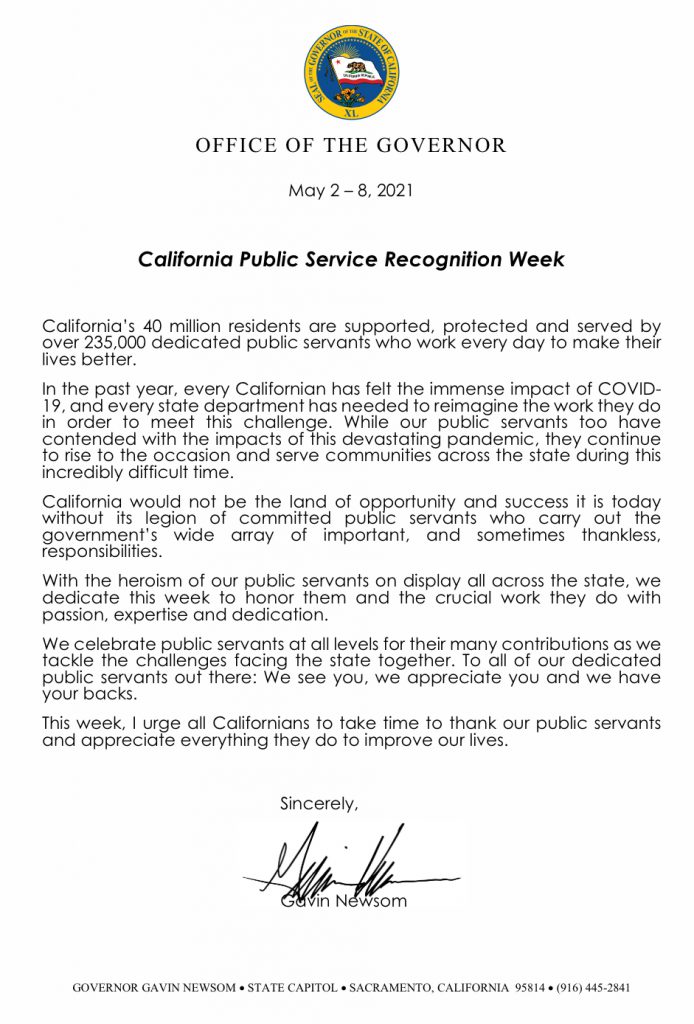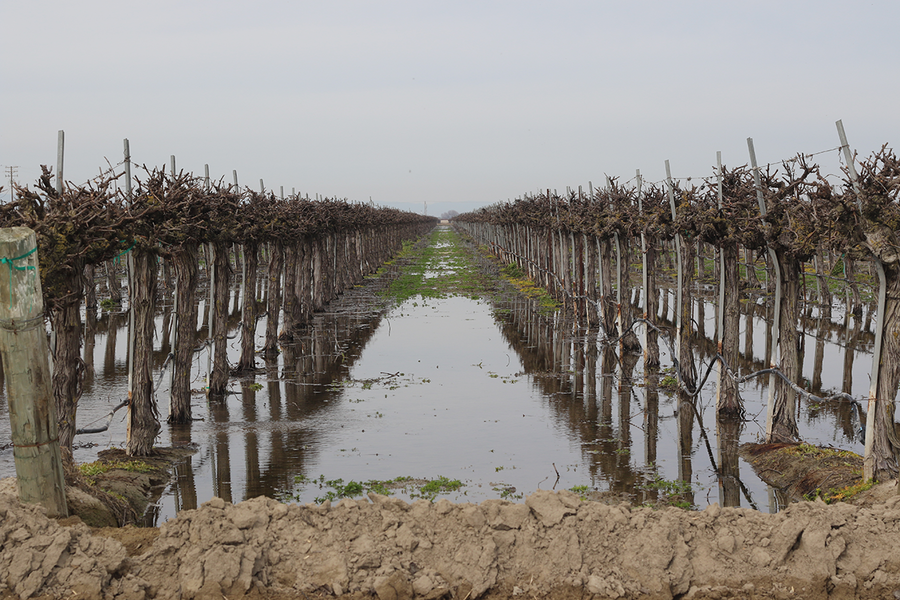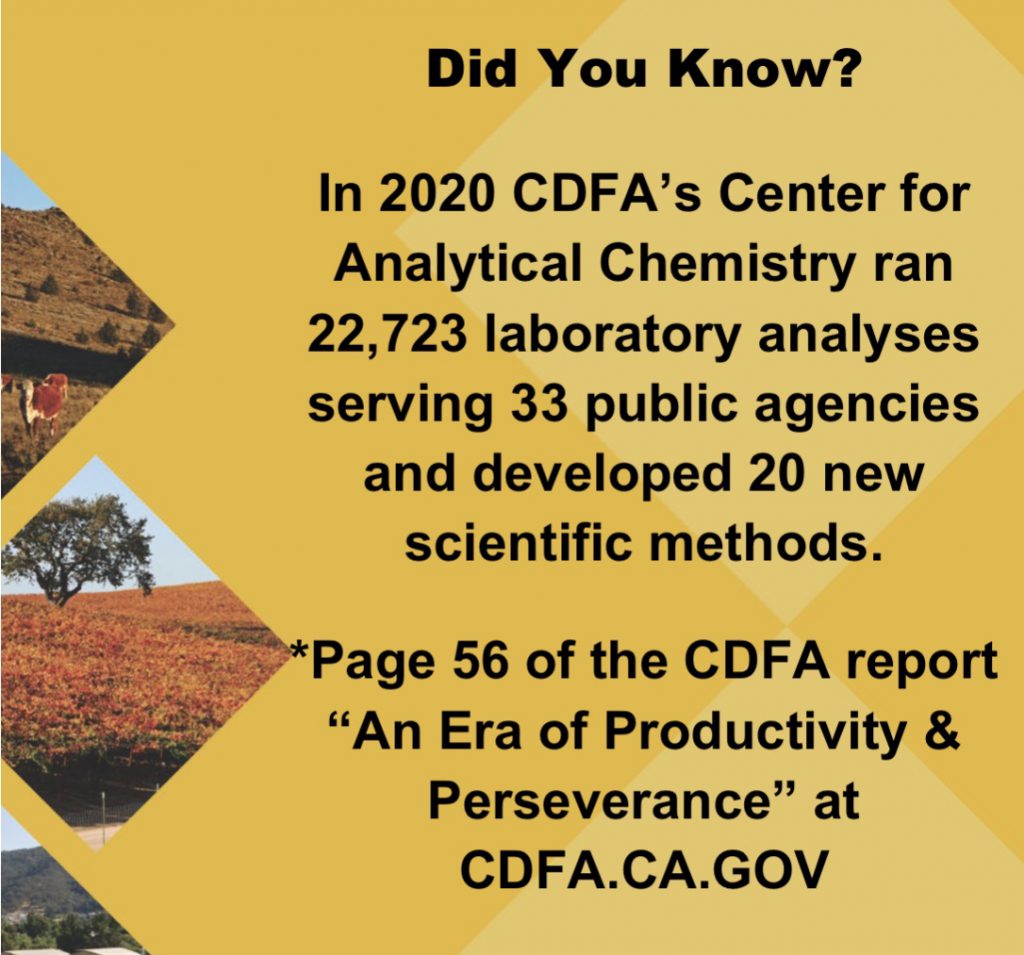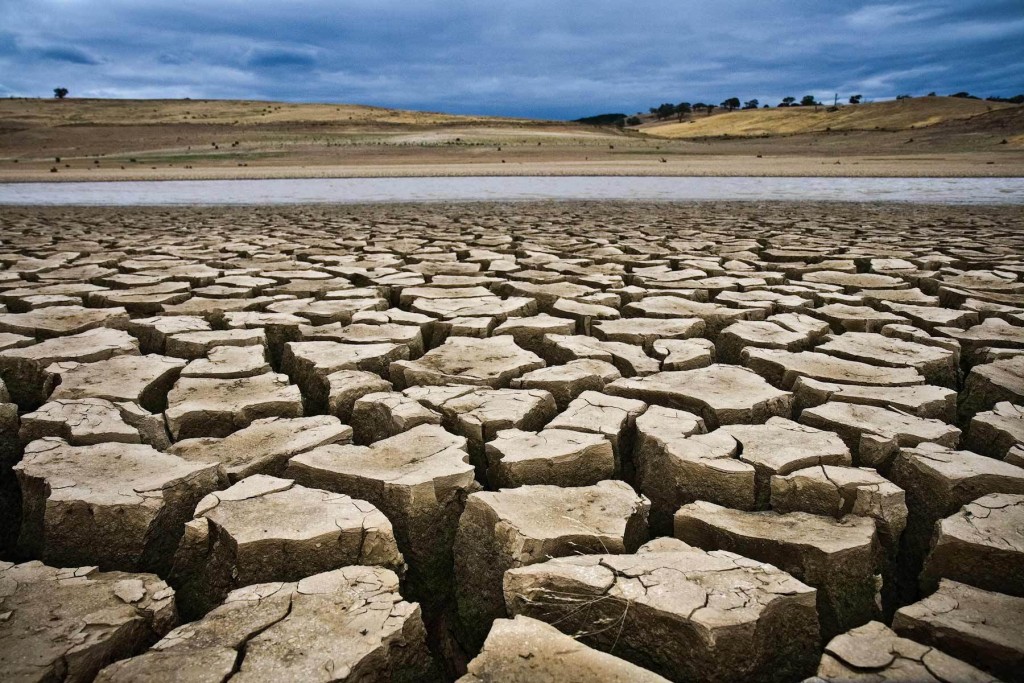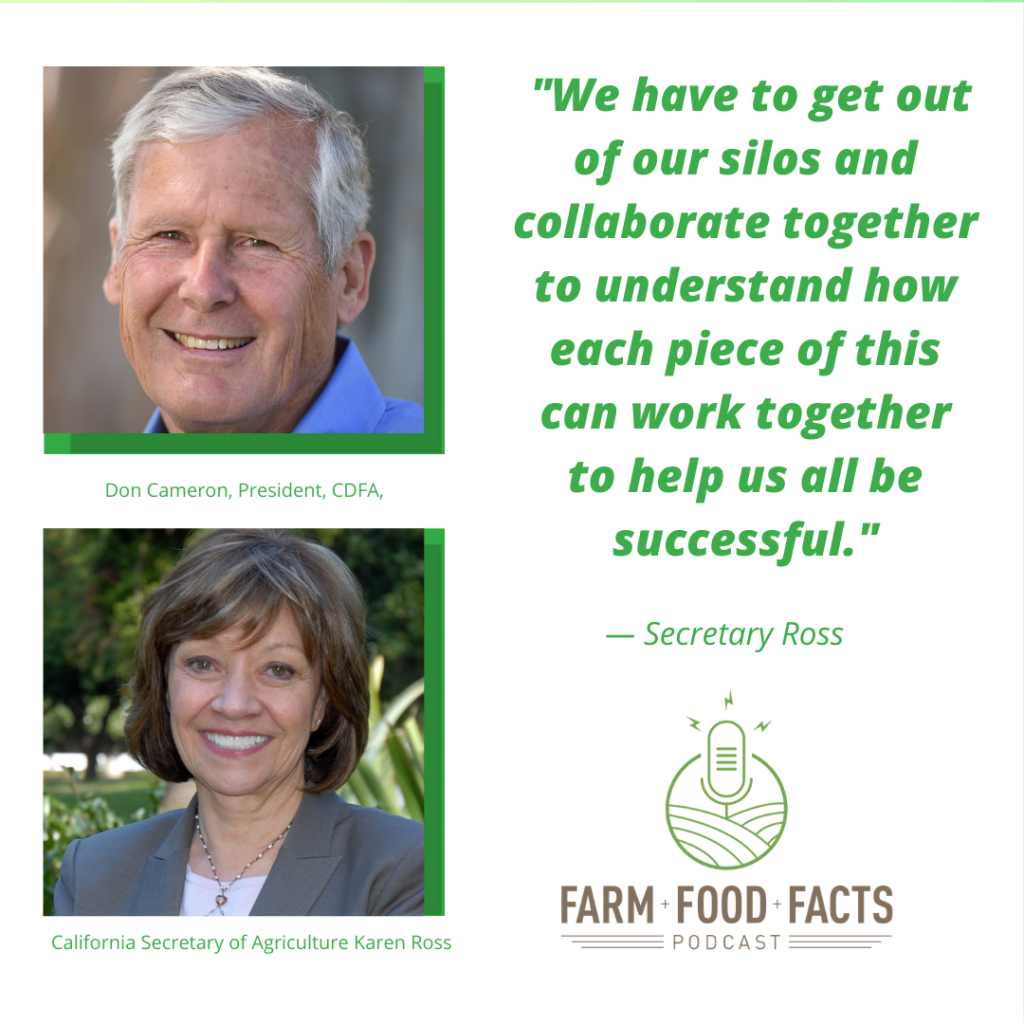-
Recent Posts
- Lowering the boom on illegal fireworks — CDFA teamed up with San Bernardino County Fire to confiscate 13 tons prior to July 4th
- $600 million for CDFA in new budget year
- A Pride Month Conversation with Cody Nicholson Stratton, of Foggy Bottoms Boys Farms
- Experience California Agriculture — Secretary Ross applauds new agritourism website from California Grown
- CDFA Celebrates Pride Month with Panel of LGBTQ+ Voices
Recent Comments
- Yvonne McCurley on A Pride Month Conversation with Cody Nicholson Stratton, of Foggy Bottoms Boys Farms
- Diana Shima on A Pride Month Conversation with Cody Nicholson Stratton, of Foggy Bottoms Boys Farms
- Andy on Experience California Agriculture — Secretary Ross applauds new agritourism website from California Grown
- EDWARD RING: Saving California’s rural water users ~ MAVEN'S NOTEBOOK | California Water News Central on Nine California Counties Make Top-10 List for Ag Sales in the U.S.
- Urban agriculture grows in the Sacramento region • Sacramento News & Review on Community Alliance for Family Farmers emergency fund for drought and pandemic relief
Archives
- July 2025
- June 2025
- May 2025
- April 2025
- March 2025
- February 2025
- January 2025
- December 2024
- November 2024
- October 2024
- September 2024
- August 2024
- July 2024
- June 2024
- May 2024
- April 2024
- March 2024
- February 2024
- January 2024
- December 2023
- November 2023
- October 2023
- September 2023
- August 2023
- July 2023
- June 2023
- May 2023
- April 2023
- March 2023
- February 2023
- January 2023
- December 2022
- November 2022
- October 2022
- September 2022
- August 2022
- July 2022
- June 2022
- May 2022
- April 2022
- March 2022
- February 2022
- January 2022
- December 2021
- November 2021
- October 2021
- September 2021
- August 2021
- July 2021
- June 2021
- May 2021
- April 2021
- March 2021
- February 2021
- January 2021
- December 2020
- November 2020
- October 2020
- September 2020
- August 2020
- July 2020
- June 2020
- May 2020
- April 2020
- March 2020
- February 2020
- January 2020
- December 2019
- November 2019
- October 2019
- September 2019
- August 2019
- July 2019
- June 2019
- May 2019
- April 2019
- March 2019
- February 2019
- January 2019
- December 2018
- November 2018
- October 2018
- September 2018
- August 2018
- July 2018
- June 2018
- May 2018
- April 2018
- March 2018
- February 2018
- January 2018
- December 2017
- November 2017
- October 2017
- September 2017
- August 2017
- July 2017
- June 2017
- May 2017
- April 2017
- March 2017
- February 2017
- January 2017
- December 2016
- November 2016
- October 2016
- September 2016
- August 2016
- July 2016
- June 2016
- May 2016
- April 2016
- March 2016
- February 2016
- January 2016
- December 2015
- November 2015
- October 2015
- September 2015
- August 2015
- July 2015
- June 2015
- May 2015
- April 2015
- March 2015
- February 2015
- January 2015
- December 2014
- November 2014
- October 2014
- September 2014
- August 2014
- July 2014
- June 2014
- May 2014
- April 2014
- March 2014
- February 2014
- January 2014
- December 2013
- November 2013
- October 2013
- September 2013
- August 2013
- July 2013
- June 2013
- May 2013
- April 2013
- March 2013
- February 2013
- January 2013
- December 2012
- November 2012
- October 2012
- September 2012
- August 2012
- July 2012
- June 2012
- May 2012
- April 2012
- March 2012
- February 2012
- January 2012
- December 2011
- November 2011
- October 2011
- September 2011
- August 2011
- July 2011
- June 2011
Categories
- AG Vision
- Agricultural Education
- Agricultural Marketing
- Alternative Fuels
- Animal health
- Animal Welfare
- Asian Citrus Psyllid
- Biodiversity
- Border stations
- BSE
- Cannabis
- Cannella Panel
- Climate Change
- Climate Smart Agriculture
- Community-based Food System
- Conservation
- Dairy
- Drought
- Environment
- Fairs
- Farm Bill
- Farm Labor
- Farmers' Markets
- Fertilizer
- Food Access
- Food Safety
- Food Waste
- Glassy-winged Sharpshooter
- Growing California
- Healthy soils
- HLB
- Hydrogen
- Integrated Pest Management (IPM)
- Invasive Species
- Light Brown Apple Moth
- Livestock ID
- Measurement Standards
- Nutrition
- Organic agriculture
- Pierce's Disease
- Pollinators
- Specialty Crops
- State Board of Food and Agriculture
- Succession Planning
- Trade
- Uncategorized
Pages
RSS

Governor Newsom on California Public Service Recognition Week
Posted in Uncategorized
Leave a comment
Grant funding awarded to six Sustainable Groundwater Management Act projects
From the Department of Water Resources
The Department of Water Resources (DWR) is awarding funding support for six projects to address the impact of the Sustainable Groundwater Management Act (SGMA). A total of $26 million in grant funding is being made available for the SGMA projects. The funding support comes from the Sustainable Groundwater Management Grant Program. Sixteen individual construction projects within Critically Overdrafted Basins will take place through the six grant awards.
The Fresno Irrigation District has been awarded nearly $4.9 million for Kings Basin 2021 GSP Implementation Projects. Mid-Kaweah GSA will use the $3.7 million grant for Kaweah Subbasin Groundwater Recharge and Sustainability Projects. The Southern Merced Subbasin Recharge Project overseen by the Merced Irrigation District will be supported by nearly $5 million. Madera County is receiving a combined $8.4 million for the East Madera Subbasin Recharge Project Phase 1 and Eastside Bypass Recharge for Subsidence and Flood Risk Reduction Phase 1. Westlands Water District GSA will receive nearly $4 million for the Pasajero Groundwater Recharge Project.
The SGMA projects include the construction of 60 wells in Fresno County to use stormwater to replenish diminished groundwater aquifers. Three projects will help develop infrastructure for Flood Managed Aquifer Recharge on 45,000 acres of farmland in Madera County. DWR is set to begin working with grantees immediately in the development and execution of the grant agreements. A second round of the grant program is set to begin in the spring of 2022 with approximately $70 million in grant funding to be made available. The grant support is made possible by Proposition 68.
Posted in Uncategorized
Leave a comment
Video — Secretary Ross thanks CDFA employees during California Public Service Recognition Week, May 2-8
Posted in Uncategorized
1 Comment
Ventura County approves $3.65 million in additional funding for pandemic assistance to farmworkers
From a Ventura County News Release
The (Ventura County) Board of Supervisors approved an additional $3.65 million in Federal Coronavirus Relief Funds to support the Farmworker Household Assistance Program (FHAP) bringing total support to more than $7.1 million to assist farmworkers and their families. This funding will provide financial aid of $1,000 to eligible households who were previously funded through this program and who still reside in the County.
“We appreciate the opportunity to provide assistance where it’s needed most. This program is important in supporting Farmworkers who are vital members of our community. This will help those who are struggling from the impacts of the pandemic and those who support us all through the agricultural products they provide throughout the year,” said County Executive Officer Mike Powers.
The Board of Supervisors approved the first FHAP program design in September 2020, which was a collaboration between the Board and a generous group of private donors comprised of agricultural employers, farmworker advocates and community-based organizations. The program required proof of residency, financial hardship due to COVID, and prioritized eligibility to farmworkers at very low-income levels of 50% or below the Average Median Income. It served 3,461 farmworker households with a $1,000 grant, a distribution that totaled just over $3 million in federal CARES Act funding in conjunction with about $400,000 in private donor funds collected in a Farmworker Household Assistance trust that was managed by VCCF. The Human Services Agency administered the program on behalf of the donor group and distributed all the funds before the end of last year.
Farmworkers have continued to work throughout the pandemic. Many experienced reductions in hours due to decreased demand for certain crops used primarily by restaurants. Others have needed to reduce their hours to care for school-age children, while still others have incurred unexpected expenses, all of which have impacted the ability to meet the most basic needs of housing, food and medical care.
“As the pandemic has continued and these farmworker households continue to struggle and endure financial hardships disproportionately, this funding aims to provide additional relief and stability while the challenges to meet basic needs persists,” said Melissa Livingston, Director of the Ventura County Human Services Agency, which is administering the program.
“These farmworker families who continue to struggle will be receiving a second $1,000 grant under the Farmworker Household Assistance Program,” said Ellen Brokaw from Brokaw Ranch Company. “Our county leaders have stepped up again to help these essential workers who also are our neighbors. Private donations currently being raised will provide further help to even more families. The need is huge. The Ventura County community cares.”
For every $0.50 that is donated to the Farmworker Household Assistance Program by private donors, the Ventura County Community Foundation will also donate $1.00 to the fund through a challenge match grant amount of up to $500,000. Every dollar donated will go directly to farmworker families in need. To donate to the FHAP, please visit www.vccf.org/fhap.
Posted in Uncategorized
Leave a comment
Secretary Ross praises appointment of Jenny Lester Moffitt as USDA undersecretary
Statement from CDFA Secretary Karen Ross:
I am thrilled that someone of Jenny Lester Moffitt’s caliber has been selected by President Biden to serve as USDA Undersecretary for Marketing and Regulatory Programs.
In Jenny’s seven years at CDFA (as undersecretary and deputy secretary) she has shown herself to be a tireless advocate for agriculture and the people of California. I have deeply valued her counsel and her leadership. She is detail-oriented and a talented problem solver who brings all stakeholders together, and her experience as a farmer places her in a very strong position to understand the challenges and opportunities ahead. I have no doubt that she’ll show the same acumen and dedication on behalf of all Americans. We are a remarkable nation with the greatest agricultural story in world history, and we have people like Jenny—working in both the production and policy arenas—to thank for it.
Jenny Lester Moffitt is a trusted colleague and a good friend, and she will be missed here in California. But I am gratified that she will be serving a larger cause. She is a shining example of the next generation of agricultural leadership.
Posted in Uncategorized
2 Comments
Secretary Ross hosts state’s FFA officers at CDFA Headquarters
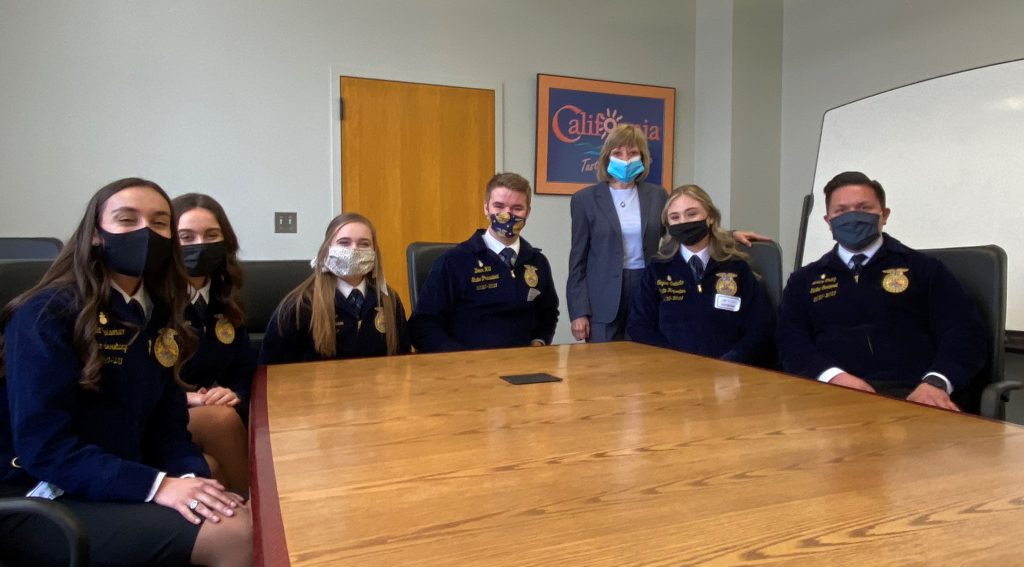
California Agriculture Secretary Karen Ross (standing) hosted the state’s FFA officers for their annual visit at CDFA Headquarters this afternoon. “It was great to be able to meet in person under the circumstances, and to hear how they’ve been so adaptable over the past year,” Secretary Ross said. “I’m looking forward to speaking at the convention in a few weeks.” Officers, from left: State Secretary Mia Arisman, State Treasurer Reese Gonsalves, State Vice President Emma Thorpe, State President Dean Hill, State Reporter Taylor Sollecito, and State Sentinel Maico Ortiz.
How dry is California? From the California Water Blog
By Jay Lund, UC Davis Professor of Civil and Environmental Engineering
California is in the second year of a drought. Governor Newsom (last) week made his first drought declaration.
Just how dry is this drought, so far? What are some likely implications? And what might State and local governments do about it?
How dry is it?
California Data Exchange Center has some excellent collections of water data: https://cdec.water.ca.gov/index.html
Precipitation – Northern California has received about 48% of average historical precipitation for this time of year. This is the 3rd driest water year on record, so far. Only 1924 and 1977 were drier in precipitation over the last 101 years. At this time of year, there will probably be little more precipitation until fall.
Snowpack – Statewide snowpack is about 30% of average for this date. Snowmelt will only help reservoir storage a little this year, but we will be glad to get any of it.
Temperatures – Temperatures have been warmer than historically, and we should watch how they develop over the year. In the 2012-2016 drought, warmer temperatures increased evaporation and dried soils much more quickly, further reducing streamflows, groundwater recharge, and stressing already-dry forests and aquatic ecosystems.
Surface water runoff – With warmer temperatures, this year might develop to rank drier in streamflow than precipitation, but it is too early to tell yet. Historically, precipitation this low would lead to Sacramento Valley annual streamflow of about 5-6 million acre-ft, compared to an average of about 18 million acre-ft., more than 2/3 loss of average surface water available.
Reservoir storage – Statewide, reservoirs are at about 74% of their long-term average. Last year was dry, and this year’s runoff hasn’t helped. The table below shows the major Sacramento Valley reservoirs are all quite low. Shasta, Oroville, Folsom, and New Bullards Bar are all lower today than they were on this date in any year of the 2012-2016 drought. This is especially concerning remembering that in both 2014 and 2015, Shasta ran out of cold water early, killing about 95% winter run juveniles, in 2014 suburban water utilities were quite worried for their Folsom supplies, and in 2015 levels were low enough to build a salinity barrier in the Delta. This drought seems to be off to a faster start than the 2012-2016 drought.
The Colorado River’s huge reservoirs are very low, 56% of average storage (only 41% of capacity). Colorado River drought plans are being triggered.
What are some likely implications?
The drought could end quickly, or it could go on for several more years. We will all hear informed (and uninformed) speculation on this. The informed speculation will be interesting, but perhaps not useful (such as the great El Nino distraction of the previous drought).
Cities seem mostly well prepared for this drought with stored surface and groundwater, and water banking and purchase agreements with farmers. They have continued drought preparation and water conservation efforts since the last drought. Conditions for cities might worsen with additional dry years, so more water purchases might be negotiated, given the surplus water conveyance capacities available this year. There will likely to be calls for more water conservation, mostly to help save water for potential additional dry years and to make some water available for other uses. Urban water use is only 20% of all water diversions, so conservation mostly tends to help cities bank water for later, but isn’t bad for others either.
Agriculture is a much greater water user and has less banked water, but still has access to considerable groundwater, which compensated for about 70% of lost irrigation water in the previous drought. Water markets and selective fallowing will further reduce the economic impacts of remaining agricultural shortages, as they did in the previous drought. Some farmers surprised by shortages in the 2012-2016 drought should be better prepared for this one, so far. Droughts these days are tougher on agriculture than cities, given their relative water demands and greater difficulties preparing irrigated agriculture for drought, especially with the growing share of more profitable, but hard-to-fallow, permanent crops. Farm worker unemployment is likely in regions with more fallowing.
Groundwater always becomes a problem during drought, with less surface water inflows and much more pumping, mostly for agriculture. Users of shallower rural wells suffer most directly from this. This drought will make implementing the State’s Sustainable Groundwater Management Act (SGMA) for ending groundwater overdraft much more difficult, but also provide opportunities for local Groundwater Sustainability Agencies and state regulatory agencies (DWR and SWRCB) to provide more forceful and specific guidance and motivations for implementing practical and effective local groundwater management (meaning more pumping cut-backs and less delusional recharge estimates).
Rural drinking water supplies always worsen with drought. This process will continue in every drought until SGMA is well-implemented and better support exists for rural water systems. A few rural water systems have been connected to more secure supplies since the last drought and quite a few deeper wells have been drilled. But we should expect to hear of rural community and household water supplies becoming scarce or dry – hopefully fewer than before.
The Delta is always dicey in drought. Lower freshwater flows greatly reduce water availability for exports and reduce water quality in various ways (not just salinity). These conditions are worse for native species and better for invasive species. It seems hard to predict exactly what will happen in the Delta’s ecosystem with drought, but it is usually not good. Although sometimes less bad than predicted, each drought seems to bring a step decline in native fishes which does not recover after the drought.
With such low reservoir levels, calls to reduce freshwater and environmental outflows from the Delta seem likely (rhetorical outrage machines will run overtime again.) Any reductions in Delta environmental outflows should probably be stored (not exported), to support environmental flows in future drought years if needed. And at the end of the drought, any remaining stored environmental water in reservoirs should be sold if it results in earlier resumption or increases in Delta exports – this has not been the case in previous droughts. Ecosystems should see some benefits from any necessary drought reductions in outflow that benefit other water users (Lund and Moyle 2015).
Ecosystems have the greatest difficulty preparing for drought, so they are the most vulnerable. We are the least organized to prepare ecosystems for drought, manage them in drought, and recover them after drought. In California’s highly variable climate, no wonder our ecosystems are declining.
Forest ecosystems will be stressed by drier and warmer-drier conditions, leading to greater spread of tree diseases and insect infestations. The previous drought killed over 100 million trees in California and increased catastrophic wildfires for several years after the drought, with wildfire damages and loss of life far greater than all traditional drought damages combined.
Native fish populations always seem to decline during drought, and fewer recover after the drought. This drought ratcheting effect on aquatic ecosystems has been part of this ecosystem’s ongoing declines.
Waterbirds need wetlands, which become scarcer during drought. Fortunately, waterbirds need less water than fish, and California’s system of national, state, NGO, and private refuges, duck clubs, and rice farming has become well organized over decades to support the Pacific Flyway. In recent droughts, these groups have collaborated, planned, and managed wetlands for migratory waterbirds quite effectively. They show what can be done when environmental interests are effectively organized and funded.
Should the Governor have already declared a statewide drought?
The Governor declared drought emergency conditions in two counties clearly hard hit by this drought and where an emergency declaration will facilitate tangible and effective state and local actions to reduce drought impacts. The Governor’s statement also moves forward a range of activities that prepare for additional State drought actions regionally and statewide, without yet making a statewide drought emergency declaration.
Droughts are long disasters, and they are mismanaged by both panic and complacency. The current measured incremental approach seems wise. It makes clear that State government is neither complacent nor panicked, and allows limited state agency resources to focus on and emphasize particularly urgent problems early while foreshadowing that other actions are being prepared, and that others should help prepare as well. It allows public and media attention to grow as drought conditions and needs worsen, and allows this attention to adapt as the situation evolves. If drought conditions become truly dire and widespread, draconian changes in public behavior will be needed. And to get such a public response, it will be necessary to maintain (and in these times build) public trust in water management institutions by acting in measured ways.
We all should prepare for a dry time, and for the likelihood of drier times. This could be a long haul, prepare earnestly, and don’t get exhausted too soon. And prepare to make one outcome of this drought be better preparation for the next drought.
Posted in Uncategorized
2 Comments
Secretary Ross, State Board of Food and Ag President Don Cameron join US Farmers and Ranchers in Action for podcast on the future of California Ag
Posted in Uncategorized
Leave a comment
Agriculture’s commitment to Earth Day – Op-ed in AgriPulse
By CDFA Secretary Karen Ross
As we observe Earth Day 2021 and look forward to a time in the not-so-distant future when we start to come together again after a very long year-plus apart, I want to take a moment to express my gratitude for everything that farmers and ranchers have done during this stressful period to further the causes of environmental stewardship and climate-smart agricultural practices. It’s important to understand that they have achieved this while never wavering from their essential purpose of providing food for a hungry world.
Throughout the COVID-19 crisis, California’s Climate Smart Agriculture programs have continued to draw extensive interest from producers. CDFA’s Healthy Soils Program, which incentivizes practices to increase soil sustainability by sequestering carbon, has received $50 million in appropriations, so far, and there is another $30 million proposed in Governor Newsom’s budget for 2021-2022. The funded projects to date are estimated to reduce greenhouse gases (GHGs) in the atmosphere by more than 112,000 metric tons per year. Co-benefits include increased water holding capacity for drought resilience, biodiversity enhancements, and improved nutrient cycling.
Dairy families are leaning-in on sustainability and methane reduction through our manure management programs, with the objectives of turning dairy waste streams into renewable energy and improving air and water quality. More than $318 million has been appropriated to these programs, so far, with a reduction of 2.3 million metric tons of GHGs per year – the equivalent of removing 495,000 cars from the road!
The State Water Efficiency and Enhancement Program (SWEEP) has invested $80 million to support farmers implementation of improved irrigation practices to conserve water and energy to reduce GHG emissions – more than 800,000 metric tons over a 10 year period along with annual water savings of 107,000 acre-feet, and all that also results in improved nutrient management! Recognizing the importance of this program, Governor Newsom’s budget has proposed $40 million for it.
Natural and working lands are key assets to helping California reach its climate goals. Governor Newsom underscored the state’s commitment with an executive order last fall calling for the development of innovative strategies for California lands to address climate change as well as protect and restore biodiversity and our ecosystems. He called on CDFA to work with agricultural stakeholders to identify farmer and rancher-led solutions. We followed that up with a series of public meetings to solicit ideas and the draft report summarizing those sessions is now out for public comment, with a deadline for comments of April 30, 2021. It is important that we listen to farmers and ranchers who are agents of change and managers of the biological system of farming as we focus on balanced policy, incentives, and technical assistance that best support and reward these land stewards for the common public good.
As we transition to a carbon-neutral economy and a more sustainable and resilient food and agriculture system, we must invest in more nature-based solutions to benefit Mother Earth. That’s why I was so excited for CDFA to join our colleagues from USDA Natural Resource Conservation Service and more than 20 other farm and non-governmental organizations in the recently announced California Pollinator Coalition to focus on increasing the value working lands provide to our environment. The member organizations represent the large majority of California’s crop and rangeland, and they’re pledging to increase habitat for pollinators on working lands. Achieving this goal will increase biodiversity and sequester more carbon in soil. California is home to more than 1,600 native bees and hundreds of other species of pollinators. Globally, pollinators provide service to more than 180,000 different plant species, more than 1,200 crops, and are responsible for producing an estimated one out of every three bites of food.
And that leads us to the whole point of observing Earth Day and beyond that, treating every day like Earth Day – we must take care of our planet so it may take care of us, and our farmers and ranchers can and will lead the way.
Posted in Uncategorized
Leave a comment


